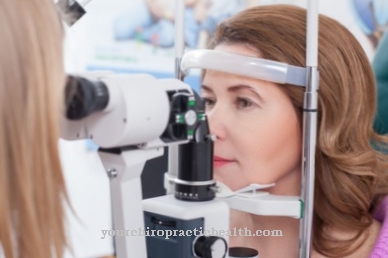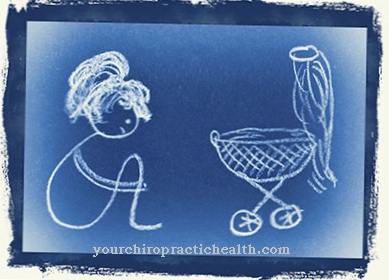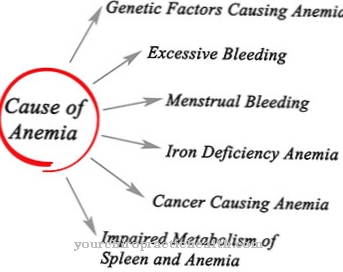As Sanfilippo Syndrome is a congenital metabolic disease that occurs very rarely. It is one of the mucopolysaccharidoses.
What is Sanfilippo Syndrome?

© ktsdesign - stock.adobe.com
At the Sanfilippo Syndrome it is a disease of the glycosaminoglycan metabolism that is inherited as an autosomal recessive trait. The disease is also called mucopolysaccharidosis type III and belongs to the group of mucopolysaccharidoses.
Depending on the genetic defect in the Sanfilippo syndrome, doctors differentiate between the four subtypes A to D. The Sanfilippo syndrome occurs only very rarely. Its frequency is 1 in 60,000. When the affected child is born, there are no noticeable symptoms. Mucopolysaccharidosis becomes noticeable between the ages of three and four years through very restless and aggressive behavior as well as the retardation of mental development.
From the second decade of life, in addition to the patient's behavioral disorders, spastic paralysis becomes apparent, the intensity of which increases. In contrast to the other mucopolysaccharidoses, the organs, apart from the brain, are less affected. There are only a few abnormalities on the skeleton and the patients are usually of normal stature.
The Sanfilippo syndrome was named after the American pediatrician and biologist Sylvester Sanfilippo. He first described the disease in 1963.
causes
The Sanfilippo syndrome is caused by inherited defects in four different enzymes. These normally have the task of breaking down the glycosaminoglycan heparan sulfate. The enzymes SGHS (N-sulfoglucosamine sulfohydrolase), NAGLU (N-alpha-acetylglucosaminidase), HGSNAT (heparan-alpha-glucosaminide N-acetyltransferase) and GNS (N-acetylglucosamine-6-sulfatase) are affected.
The heparan sulfate is not broken down by the genetic defect, so it is stored in the lysosomes. These are the functional subunits of the cells that are surrounded by their own membrane. As the nerve cells become increasingly overloaded, this leads to disturbances in the functionality of the lysosomes, which in turn leads to discomfort. The bones and other organs are not affected as much by the disturbances as with other mucopolysaccharidoses because the heparan sulfate storage is lower in them.
Symptoms, ailments & signs
All four forms of Sanfilippo syndrome show a uniform picture of disabilities. Those affected experience significant physical and mental changes such as dementia or behavioral disorders. Other disorders such as hepatomegaly (enlarged liver) can also occur.
Outwardly, the Sanfilippo syndrome is noticeable through an enlarged tongue, full lips, a flat bridge of the nose and the protrusion of rough facial features. The main hair falls out very shaggy. In addition, the eyebrows that merge into one another are thick and bushy. The affected children are becoming more and more behavioral and aggressive. Not infrequently they tend to be destructive.
Since they lose their understanding of speech, they stop speaking. Instead, they prefer gestures and facial expressions. Other possible signs include a higher susceptibility to infections, restricted joint mobility, inguinal and umbilical hernias and sleep problems. In some cases, optic nerve atrophy is also present.
In the further course of the Sanfilippo syndrome, symptoms of paralysis appear. The sick children move more and more unsafe and ultimately lose their ability to walk completely. Swallowing disorders and epileptic seizures are also possible.
Diagnosis & course of disease
If Sanfilippo syndrome is suspected, the treating doctor will determine the glycosaminoglycans in the urine. However, it is possible that the amount increases only slightly in mucopolysaccharidosis type III. For this reason, electrophoresis is carried out in order to obtain a reliable diagnosis.
By using them, the increased excretion of heparan sulfate can be clearly identified. The diagnosis can also be made by determining the enzyme processes within the leukocytes (white blood cells) or in the fibroblasts. The course of Sanfilippo syndrome varies from person to person.
Depending on how severe the disease is, the patient dies in the second or third decade of life. In most cases, there is a significant loss of motor and mental abilities beforehand. It is hardly possible to make meaningful contact with the disabled children. The death of the person concerned is usually caused by pneumonia.
Complications
Typically, people with Sanfilippo syndrome suffer from a number of different disabilities. These have a very negative effect on the quality of life of the patient, so that in many cases they are dependent on the help of other people in their lives. Dementia or various behavioral disorders can also occur and thus significantly limit the development of the person affected.
Sometimes the Sanfilippo syndrome leads to an enlarged liver and thus possibly to pain. Due to the coarse facial features, the syndrome often also leads to bullying or teasing, so that the patients can also develop depression or other mental disorders. A higher susceptibility to infections or sleep problems also occur frequently and lead to severe restrictions in everyday life.
Many of those affected also suffer from swallowing difficulties and thus from discomfort when taking food and fluids. Due to epileptic seizures, the life expectancy of the person affected may be significantly reduced. Unfortunately, treatment can only be symptomatic and depends on the symptoms. There are no particular complications. In addition, relatives or parents are often affected by the psychological complaints.
When should you go to the doctor?
Sanfilippo syndrome must always be treated by a doctor. Self-healing cannot occur, and in most cases the symptoms will continue to worsen if treatment for the syndrome is not initiated. A doctor should be consulted if the person concerned suffers from severe psychological changes. This often leads to psychoses, depression or other disorders of the psyche. In most cases, these symptoms appear relatively suddenly and for no particular reason, and they significantly reduce the person's quality of life. This can also lead to changes in facial features.
Should these symptoms occur, a doctor must be consulted in any case. Furthermore, sleep problems or a very high susceptibility to infections can indicate the Sanfilippo syndrome and should also be examined by a doctor. In some cases, sudden difficulty swallowing also suggest this condition. In the case of Sanfilippo syndrome, a general practitioner can primarily be seen. Further treatment usually takes place by a specialist. Since the Sanfilippo syndrome is still relatively unexplored, no general prognosis can be given about the further course.
Therapy & Treatment
Treatment of the causes of Sanfilippo syndrome is not possible because it is a hereditary disease. Studies on enzyme replacement therapy for mucopolysaccharidosis IIIa have been underway since 2014. A special gene therapy is being tested for the treatment of mucopolysaccharidosis II. For certain forms of mucopolysaccharidosis, a bone marrow transplant is considered helpful and can alleviate the disease if it takes place before the onset of the skeletal changes.
In contrast to other mucopolysaccharidoses, there is still no approved enzyme replacement therapy for Sanfilippo syndrome. In order to treat the disease symptomatically, drugs are administered against the sleep disorders and hyperactivity. However, the effects of the drugs vary from child to child. There is a risk that the preparations used will lose their positive effect after a certain period of time. It is therefore often necessary to find out an individually suitable form of therapy for the patient.
If the affected children suffer from strong, aggressive or hyperactive behavior, protective measures must often be taken in their home environment to prevent injuries. If you have difficulty swallowing, it is recommended to switch to a pulpy food. In some cases, a nasogastric tube is required.
You can find your medication here
➔ Medicines for painprevention
The Sanfilippo syndrome is one of the hereditary diseases. Because of this, there are no effective preventive measures against the disease.
Aftercare
Sanfilippo syndrome is a hereditary disorder that allows only limited follow-up care and prevention. There is no effective protection for the patient. Due to the congenital illness of the children, aftercare is mainly the responsibility of the parents. Depending on the behavior of the sick child, these can alleviate the symptoms through de-escalating measures or psychotherapy.
Doctors advise avoiding everyday stress and hectic situations in order to ease the problems with the syndrome. The aftercare is therefore about reducing stress factors, among other things. If possible, conflicts should be resolved quickly so that the child is not exposed to excessive stress. The induction of rest phases for regeneration helps to regulate the stress level.
For this purpose, the families concerned should also speak to other people in their immediate vicinity. An explanation protects against misunderstandings and further problems. At the same time, the offspring must not suffer from excessive demands. Therefore, parents should by no means make direct comparisons with other children, as this would exert pressure. The motor disorders associated with the disease can be reduced through appropriate psychotherapy.
You can do that yourself
The disease is a congenital disorder. The self-help measures are therefore to be carried out in particular by relatives and parents. It is up to you to develop strategies in good time so that de-escalation can take place as quickly as possible if the child shows aggressive behavior.
Stress and hectic everyday life should therefore be avoided. A regular daily routine can help reduce potential stressors. Conflicts should be conducted constructively and clarifications of different opinions or views should be sought as soon as possible. The child needs sufficient rest periods so that regeneration can take place and the impressions recorded can be processed as quickly as possible. To prevent adversity, people from the social environment should be informed and educated about the disease and its symptoms.
Due to delays in intellectual development, it is important to ensure that the offspring is not overwhelmed during the development phase. Comparisons with playmates and schoolmates of the same age are not permitted. Pressure and restlessness while learning new skills should also be avoided. Since there are disorders of the musculoskeletal system, physiotherapeutic measures help to alleviate symptoms. These can be carried out independently. The child's sleep hygiene must also be checked at regular intervals and optimized according to natural needs.

.jpg)



.jpg)







.jpg)











.jpg)


